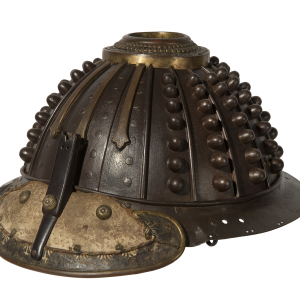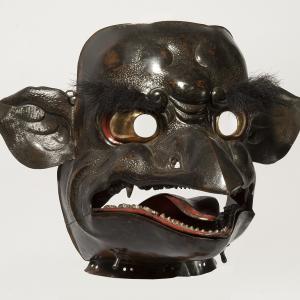Since the Heian Period (794-1185) the typical Japanese helmet had a bowl-shape (hachi), composed of triangular plates placed side by side with the edges riveted to each other so as to form a system of rib joints (suji).
This type is called sujikabuto, "ribbed helmet" and, although it is quite light, it is remarkably rigid and offers excellent resistance to a blow from a sword. When the helmet is reinforced by sloping bosses arranged along the plates, it is called hoshikabuto, "star helmet".
An opening called hachimanza was usually made at the top, often decorated with one or more overlapping rings in the shape of a stylized chrysanthemum. The accessories with which the helmet was equipped were indispensable to enhance its protective function. A neck roll (shikoro), attached to the back of the helmet protected the neck: it was formed by two or more curved blades in lacquered iron of gradually increasing diameter, which being joined together horizontally with sturdy flat coloured braided silk laces, could withdraw without resisting the movements of the head and arms. Two wing like side panels (fukigaeshi), sometimes obtained by folding the first blade of the shikoro backwards, protected the temples. The visor (mabisashi), fastened with rivets, was often internally lacquered in red. The decorations were of two types: coats of arms (mon) and friezes (dates). The coat of arms of the feudal clan to which the warrior belonged appeared on two flaps, painted in gold on a black lacquer background or applied, fretworked and chiseled into a golden metal plate. The friezes could be arranged in four different positions: the maedate decorated the front; the wakidate was fixed on both sides, behind the waving flaps; the kashiradate surmounted the hachimanza opening; theushirodate was mounted on the back, above the neck roll. Often the front frieze was of the somewhat flat kuwagata type, made of brass or golden copper alloy in the shape of a crescent, horns or antennas.
The helmets were reserved for the daimyō and the samurai, while soldiers of lower rank wore jingasa, iron, leather or lacquered papier mache war hats. Sometimes these hats were also used by the daimyō during the exercises and were therefore of high quality and at least as robust as the helmets. The most usual form, called ichimonji, has a large round brim and a conical wall.
Masks accompanied and completed the helmet, full masks, called menpo, totally protected the face, or half masks (hoate) protected the lower half of the face: they sometimes had a terrifying or furious appearance, therefore being called ressei menpo.






